5 Best Workout Plans for Skinny Guys to Build Muscle Fast

So you’re skinny, and you want to build muscle fast.
You know you need a good workout plan. So you type “workout plan” into Google and you get 147 million results in 0.62 seconds. Ugh. How do you choose?
The problem with workouts on Google
As a certified personal trainer, I’ve helped dozens of skinny guys build muscle over almost a decade.
So, I can tell from experience that the workouts on Google often fall short. Sure, they cover the basics like exercises, sets, and reps. But they don’t always give you the answer to…
- Should I train as hard as possible every workout?
- Should I do all my sets to failure?
- Should I go for full-body workouts or a split program?
Workouts on Google also often fail to cover advanced tactics like reps in reserve (RIR). Yet in the long run, using these tactics can make the difference between getting ho-hum results and “Man! Nice shape!!”
In short, you have to choose the right program!
Why my workouts here are different
Trainers, athletes, and celebrities post new workouts every day across the Web, YouTube, and Instagram. With so many workouts to choose from, why should you try my workouts here?
Well, for starters, I’m not just going to give you just one workout plan. That would be a mistake, because even the best workout in the world may not work for you.
Instead, I’m going to give you 5 workout plans. All 5 plans are for skinny guys who want to gain muscle fast. And they all go beyond the basics like “Biceps Curls: 3 x 10 reps”…
But here’s why these workouts are really different. For each program, I’m also going to tell you:
- Who’s it’s for
- Who’s it’s not for
- Why you might want to choose that program over another
That way, you can select the workout plan that suits you the most. And that means more muscle, strength, and a better physique down the line.
To help you choose your program, I’m also going to share a few lesser-known training tips to build muscle faster as a skinny guy. By the way, this blog has a smart workout app that automates these tips, programs, and more (try it free). Ready? Let’s jump in.
How you can build muscle faster as a skinny guy
Before we dive into the programs, I would like to give an overview of how I’ve decided to structure the training progression. To do so, I will be using the most recent research-based guidelines. So before we dive into the actual programs, I’ll give a look at the research on Training Volume, Frequency, Intensity and Intensity of Effort.
If you want to read more about nutrition, metabolism, myths, and everything that makes a skinny guy “skinny”, then check out my companion guide How to Gain Muscle as a Skinny Guy (Eat & Train for Your Body Type).
Train less to build more muscle
First things first. We know that training volume is arguable one of the most important variables related to hypertrophy. But if we want to grow muscle mass then we need to make sure we’re not exaggerating with it. At the same time though, we need to make sure we’re not leaving “gains on the table” either.
More often than not, skinny guys who sign up for a gym membership end up following routines that are hardly producing any results. And that’s mainly because they’re trying to gain muscle too quickly, by following outrageous training volume programs.
“More work is always better, right ?” Wrong
Let’s look at the research that looks into Training Volume and its relationship with muscle growth. We can see that increases in training volume indeed produce greater gains in muscle hypertrophy, almost linearly (Schoenfeld et al. 2016).
However, that’s the case when volume is intended as “sets taken to failure” (Baz-Valle et al. 2021), and not volume load (Schoenfeld et al. 2014)…
In other words, it’s not about how many sets or reps we do, but rather how intense said reps and sets are. And there’s actually plenty of data to support this model (Haun et al. 2018; Amirthalingam et al. 2017; Hackett et al. 2018; Heaselgrave et al. 2019).
Basically, we can get great results even with low/medium amounts of work, as long as we’re training hard enough. Assuming we’re stimulating the working muscle fibers with enough tension. This, over time, will lead to growth.
In more practical terms, we can choose to train with as little as 5-10 hard sets per muscle group per week (for beginners). Increasing it up to 15-20 hard sets per muscle group (for more advanced lifters), for optimal, long term progression.
What’s a “hard set”, you may ask ?. Well, a hard set is basically a set taken to (or close to) task failure. This means that the intensity of effort exertion is maximal/close to maximal.
Avoid “bro-splits” (do this instead)
Skinny guys love “bro-splits” because that’s generally what they’re given on sight, as soon as they sign up for their gym membership. High amounts of volume, with 20-30 sets of any chest machines on a given Monday, is their bread and butter.
Yet, they see no results…How about we split total weekly volume on multiple sessions per week? This way we’re able to recover and re-train the muscles hard more frequently…
A great meta-analysis looked exactly into that. In fact if we look at the paper, it concludes that:
“Training volume should be spread within a minimum of 2 sessions per week, in order to promote superior hypertrophic outcomes” (Schoenfeld et al. 2016).
This means that for superior results, we should be training our muscles hard, at least twice a week.
Think about it. If we can train the same muscle group multiple times a week, it allows us to train harder (during each session) but also recover faster. Provided the right amount of volume per session. This allows us to progress quickly, and really accelerate our results.
Training to failure?
Many skinny guys love training to failure. And while there’s certainly a lot of benefit in doing so, it’s certainly more nouanced than this. If we want to really do things right we need to understand *how often* we should train *that* hard.
In reality, this is a tougher question to answer without context. What feels “hard” is subjective and it differs for everyone of us depending on our training experience, gender, age, and more. Even your current training split plays a role. Depending on the amount of weekly volume you may be performing, you’d also be dictating how hard you should (or should not) train.
For this reason, I’ll try to give some guidelines by taking a look at how we can gauge effort in a given set. And I’ll do so by using reps in reserve (RIR) as a metric.
1 unique trick from a powerlifting world champion
In 2009, Mike Tuchscherer became the first American man to win gold at the Powerlifting World Games.
His unique training style is based on “reps in reserve”. By keeping track of how many reps you have in reserve, you can fine-tune your training and get in shape faster. This proven system has helped athletes break world records.
This brings me to the last topic of the article which is auto-regulation, and knowing how hard sets should feel.
Generally, us coaches like to use different methods to gauge the intensity of effort exertion on a set-to-set basis. In this case we’re going to take a look at RIR or “reps in reserve”.
When we want to make progress, our body needs to progressively get accustomed to progressive stimuli. And these stimuli can come in many different forms. To name a few, adding more weight, or more repetitions within a given set, performing more total working sets. These are all part of what’s intended with “Progressive Overload”, which is the main driver of hypertorphy.
However, if we’re not able to gauge effort accurately during our sessions, then we can end up doing “too much too soon”. Accumulating excessive amounts of fatigue as a result. This can hurt our fitness, and end up slowing down our progress.
Using reps in reserve (RIR) is a great method to use in order to gauge effort in a given training set. In practical terms, it’s used to indicate “how many repetitions left we have in the tank” before we reach task failure (Helms et al. 2018).
How does RIR work?
Let’s say we can perform 10 repetitions max with a given weight. If we reach the 10th repetition and and we’re not able to get the 11th, that set was a 0RIR. We have 0 reps in the tank. If instead we stop at 8 reps, (leaving around 2 reps in the tank) that would be called a 2RIR. That’s pretty much how it works.
But how can we tell if we’re reaching task failure?
A great metric to use whether or not you’re close to task failure, is using rep speed velocity. In fact, multiple studies show a great relationship between velocity loss and proximity to failure (Riscart Lopez et al. 2021; Pareja-Blanco et al. 2017). I see gauging RIR through rep speed as a “skill”. It gets perfected with experience, so don’t get discouraged if you can’t be accurate with it at the beginning.
Generally, I’d recommend staying within a 1-3 RIR and occasionally hitting true task failure (0RIR). Stay on the higher RIR (2-3) side if you’re a beginner since you will still need to get accustomed to the exercises. Conversely, use the lower end RIR (1-2) as you progress in your journey, and become more advanced. This way, we’re ensuring we exert high levels of effort and really getting the most out of our training sets.
Workout plans for skinny guys to build muscle
We’ve just seen how training programs are really more than just sets and reps. Especially if we want to make faster progress and really focus on other variables that truly matter.
Gauging the right amount of effort we need to exert during our training sets is extremely important. And as we’ve seen in this article, we really need to focus on it for superior results.
Anyway, here’s a quick recap video that summarizes the main points of the article.
Intensity of Effort, RIR and structuring a great training program for hypertrophy
And with that said, let’s put what we’ve learned together into practice, and see how we can apply this knowledge to our following plans!
Upper/Lower Powerbuilding Gym Split
This program follows a weekly, linear progression.
I’ve decided to structure the exercise order for these sessions by accounting for energy levels during the workout. This means placing an emphasis on strength-oriented, compound movements at the beginning of the workout, moving onto more isolating/less-demanding exercises as we progress in our session.
This way, we’re getting the best of both worlds: strength progression in the compound movements, with the additional volume for other body parts, in order to stimulate all the muscles of our body. A “powerbuilding” type program, if you will.
Best for, and why
This program is preferably suited for Intermediate lifters as it contains slightly more advanced training styles. If you have access to a gym and have the possibility to workout 4 times a week, then this program is going to be the right choice for you.
It has the right amount of training volume per session that ensures a steady progression, and a good variety of exercises that really focus on building strength and hypertrophy. But that’s not all: I’ve also included some “fun” training styles that add variety (and challenge) to the split.
If you want to start taking your training seriously with heavy barbell training, then look no further than the Upper Lower Powerbuilding Gym Split!
Table 1—Session A: Upper Strength and Hypertrophy with Back off Sets

Table 2—Session B: Lower Strength and Hypertrophy with Back off Sets
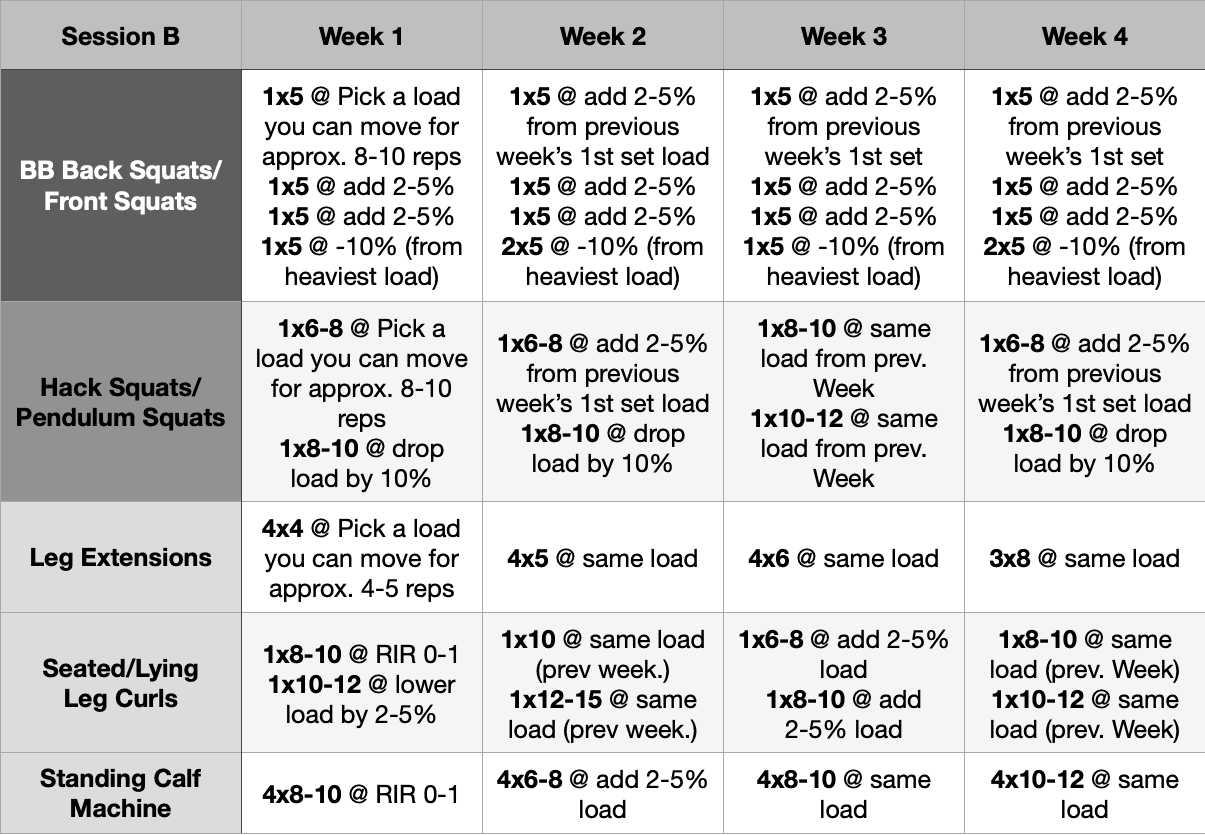
Table 3—Session C: Upper Strength + Accessory
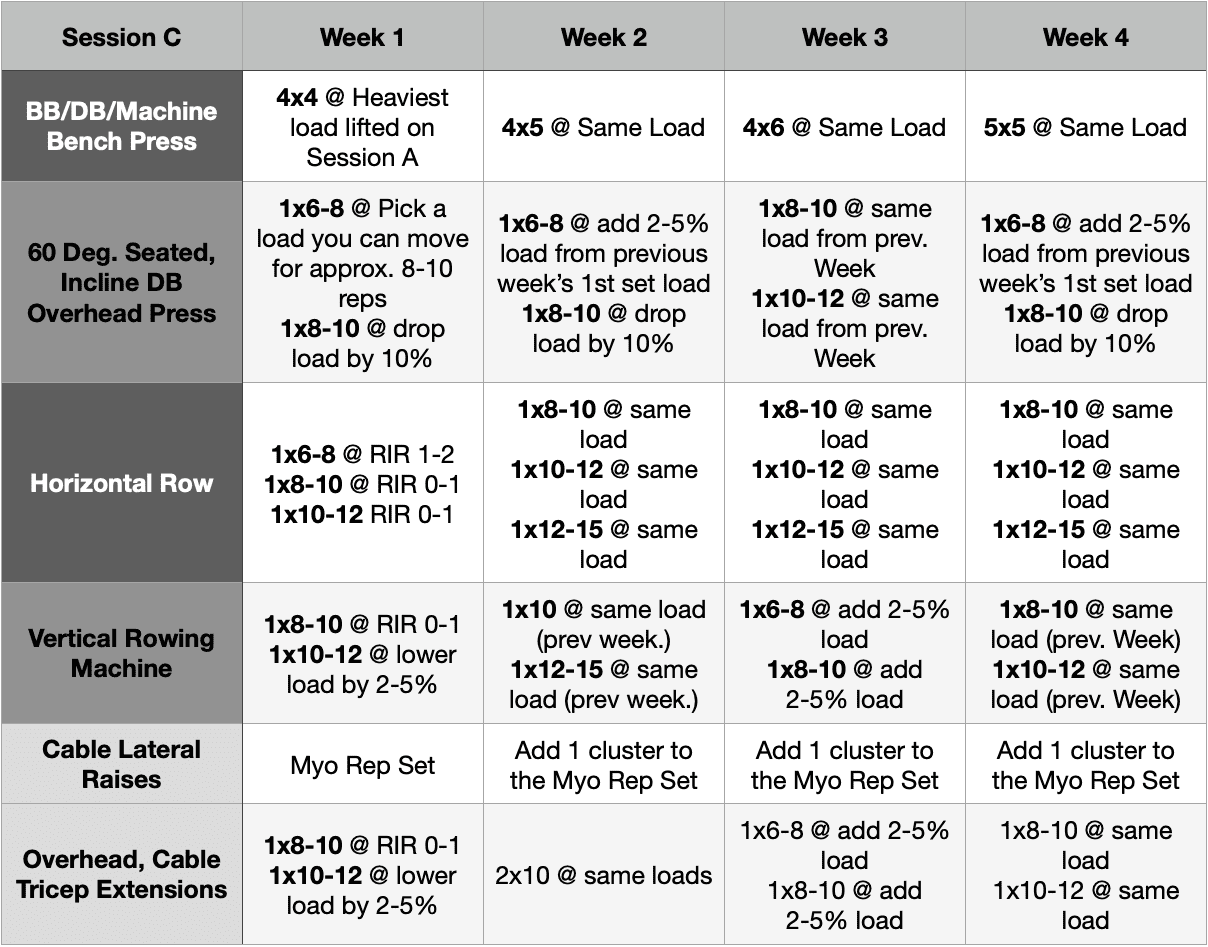
Table 4—Session D: Lower Strength + Accessory

Program instructions
Power Exercises: The compound lifts will follow an Ascending Pyramid Style Training, for the first 3 sets. These will be followed by back off sets (-10% in load), to accumulate more volume.
Basically, you’ll use the first 3 sets to ramp up in load. The last 3 sets are calculated off of your heaviest set, and they’ll all be performed with a -10% in total load.
These sets will get harder and harder as you’ll progress, because the goal will be to add one more repetition to the set, or a small amount of weight, each week. Whether you want to progress on “one set” at a time/week, or progress on all three ascending sets, is up to you. That’ll be largely dictated by your training experience.
Note: if you’re a beginner and still want to give this program a go, stick to only doing the top 3 progressive sets. As you’ll get more accustomed to the program, then start adding 1 up to 3, total back off sets.
Machine/Other accessory Exercises: Other exercises will follow a linear progression, working on either increasing the amount of repetitions performed for each set, the load, or adding one more set to the total training volume. Progression is the name of the game, so we need to expose ourselves to more stimuli.
Myo Reps (rest-pause training) and how to perform it:
Myo Rep Exercises: For some exercises I’ve decided to add Myo Rep Working or “Rest Pause” training. These exercises will work to “finish off” the targeted muscles and add variety to the training plan. Training at high levels of effort exertion within the calibrated amount of volume is mandatory for muscle growth, and this style of training can work great to do so.
How to do Myo Rep Sets: Select a weight you can do around 20 reps with (40-50% of your 1RM), and perform your first activation set. From there, rest for about 15-20 seconds (or 3-5 deep breaths) before doing your following mini/cluster sets. Each cluster should equal to 1/4 of the reps performed in the activation set.
So if you perform 20 reps on the activation set, that means 5 reps for each mini cluster.
The goal is to maintain motor unit recruitment high (thanks to the low amounts of rest between sets), and reach task failure. “Task failure” is the point in which you’re no longer able to complete another repetition. The exercise ends once you’re no longer able to perform the “required” amounts of reps for the cluster set.
Myo Rep Set Example: 20, 5, 5, 4 or 20, 5, 3 or 16, 4, 4, 2 or 20, 5, 2Huge at Home: Reverse Pyramid for Muscle & Strength
The second training plan that we’re going to showcase is a 4-Day, Lower /Upper Split, which follows a linear progression. The program is applicable in the settings of a Home Gym Set Up.
The structure of this program also accounts for energy levels during the workout, with an emphasis on strength-oriented exercises, moving onto more isolating/less-demanding exercises as we progress in our session.
Best for, and why:
The Home gym split can definitely be accessed by beginner level trainees. This program can be a valid option as it has is slightly less volume and allows very fast progression through the Reverse Pyramid Training style.
Exercise variation can result limited due to the equipment availability (since the program is thought for a gym set up). However, there will still be a good variety of bio-mechanically different movements to make sessions fun and challenging at the same time.
Table 5—Session A: Lower Power Training + Core
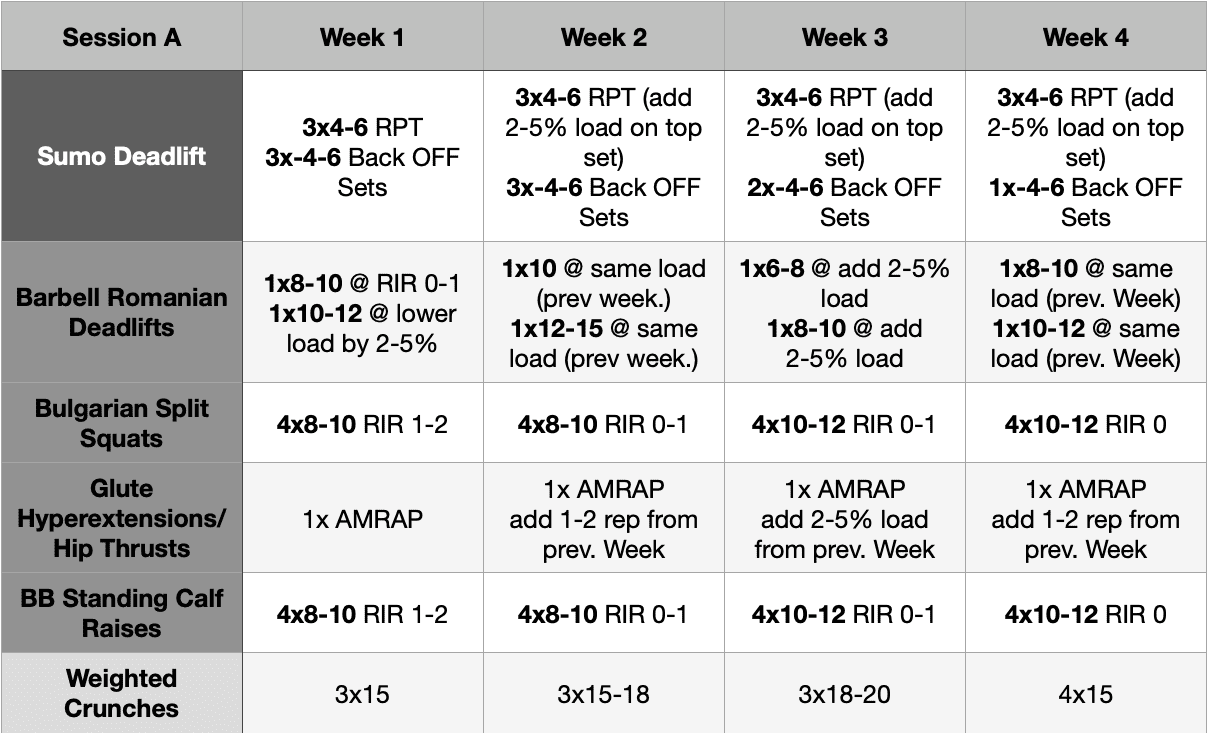
Table 6—Session B: Upper Strength + Accessory
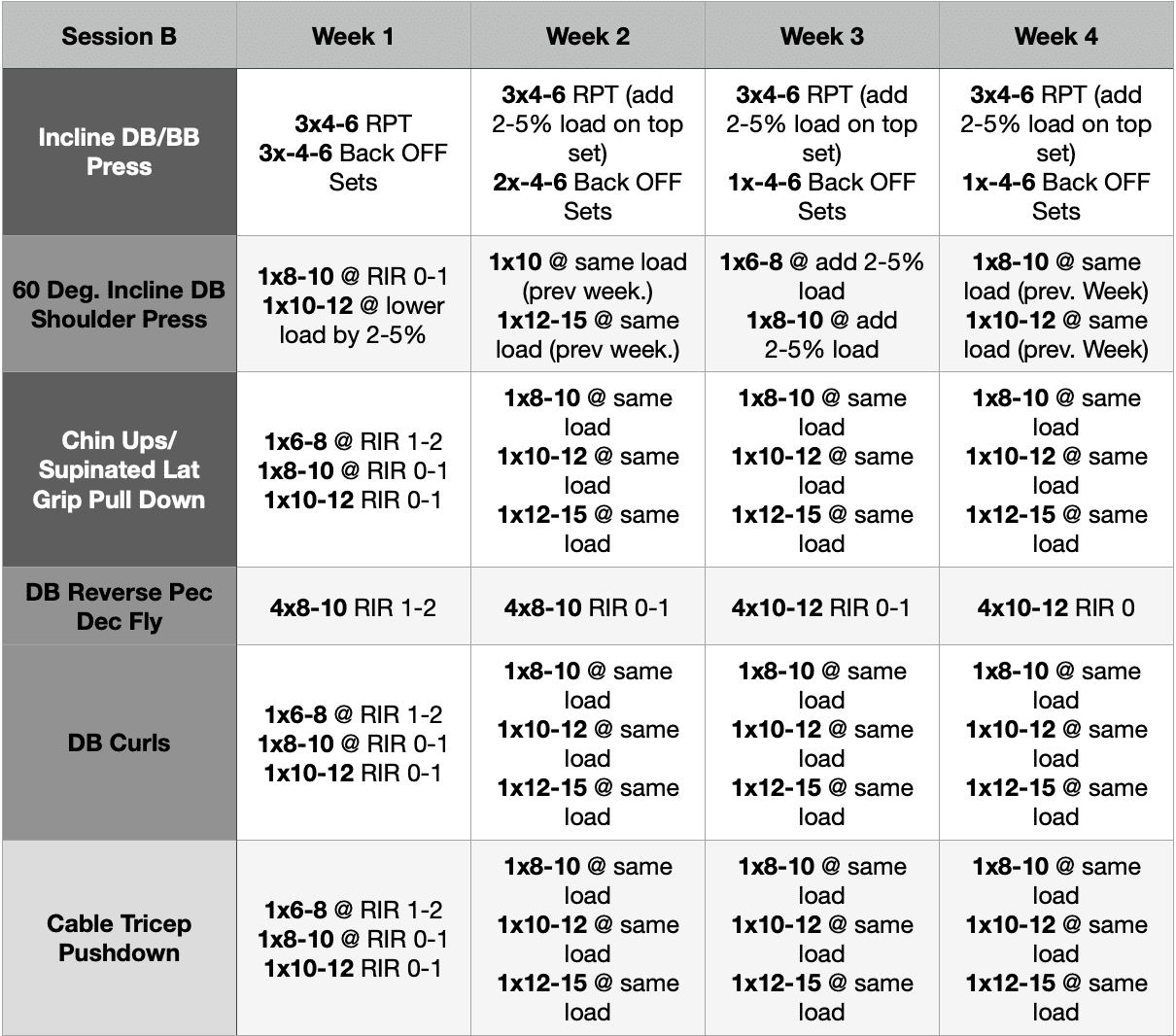
Table 7—Session C: Lower Accessory + Core
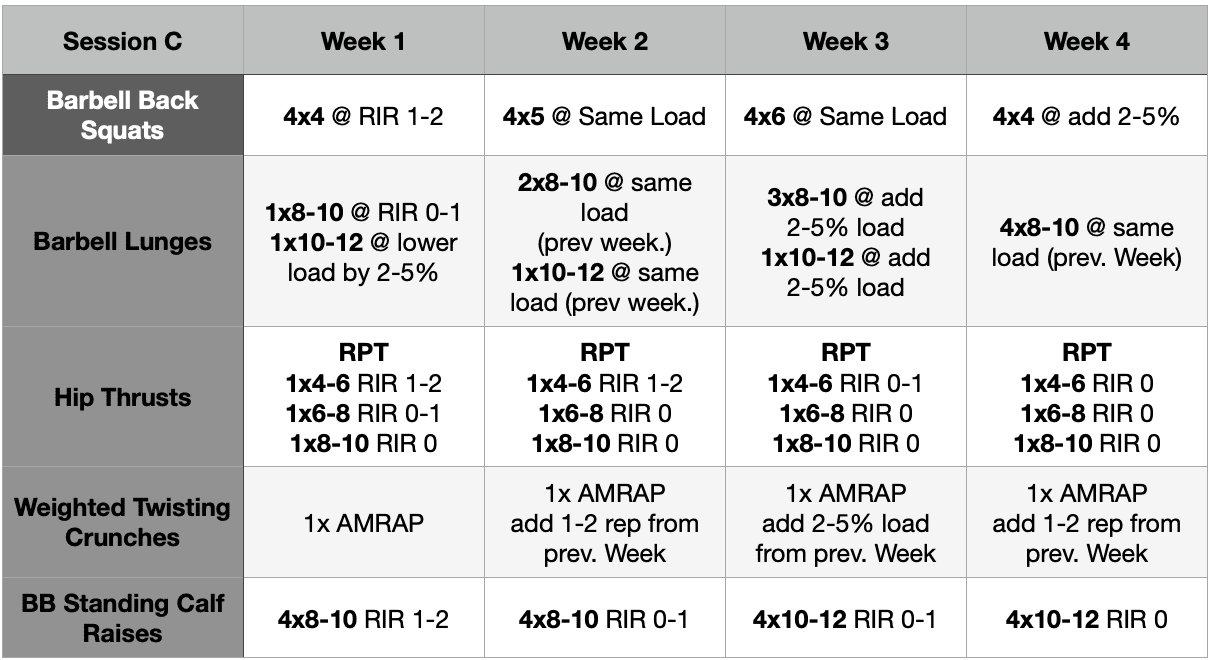
Table 8—Session D: Upper Power Training
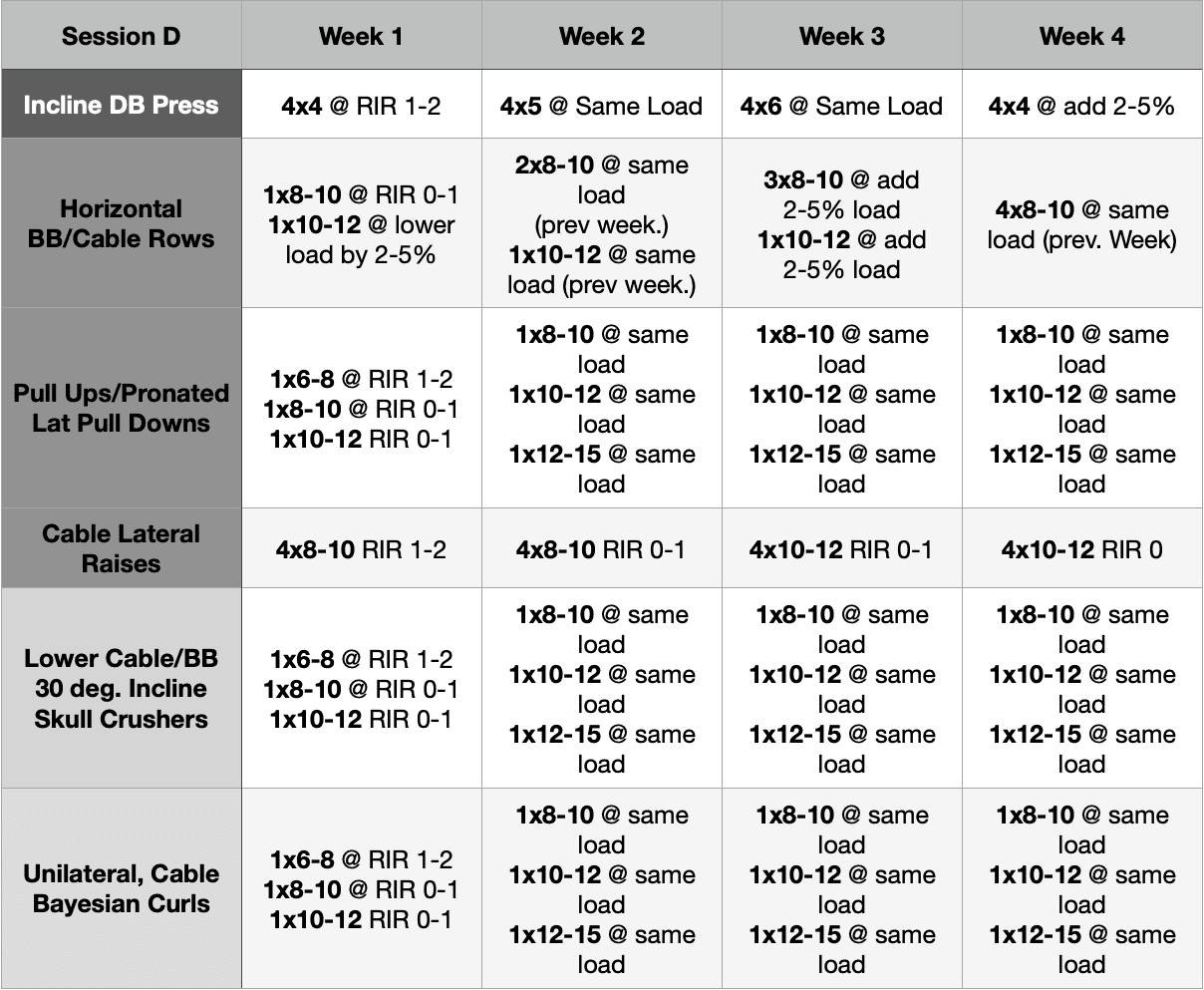
Program Instructions:
Power Exercises: Squats, Bench and Deadlift progressions will follow a Reverse Pyramid Style Training for the first 3 sets. The following ones are back off sets (-10% load) to accumulate more volume.
Machine/Other accessory Exercises: Other exercises will follow a mix of Reverse Pyramid Training + a standard progression, working on either increasing the amount of repetitions performed for each set, increasing the load, or adding one more total set to the total training volume for the week. Progression is the name of the game, and if we want to measure results, we need to do so by constantly exposing ourselves to more stimuli. And adapt.
Coach Tips on progression
Keep in mind that sets get harder as you progress each week. As always, the goal is to add one more repetition to the set, or a small amount of weight, each week. So don’t rush it and really try to maximize the quality of the repetitions you’re performing. If the progression is too fast for you, take your time with it and scale back on intensity.
No-Equipment, Full-Body Beast
The third training program will be a no-Equipment, full-body workout, which can be repeated multiple times a week. Based on your training experience, you can decide how many times a week you can do it. Personally I recommend to start with 2-3 sessions a week, building your way up to a 4 times per week.
Since we don’t have any resistance (load) to work with, the only two variables that we can really work with will be Volume (intended as number of sets and reps), and Frequency (how many days we train/week).
This means we’ll have to train to failure more often, because the goal will still be to train at high enough levels of effort exertion in order to stimulate muscle growth.
Best for, and why:
The no-equipment training program is more for beginner-level trainees. But don’t be fooled: this program can still be a great challenge to those who seek strength gains through bodyweight movements. By training more often to failure, even bodyweight exercise can help fatigue the muscles and really make those hard reps count for hypertrophy.
Table 9—Session A: Full body Blast
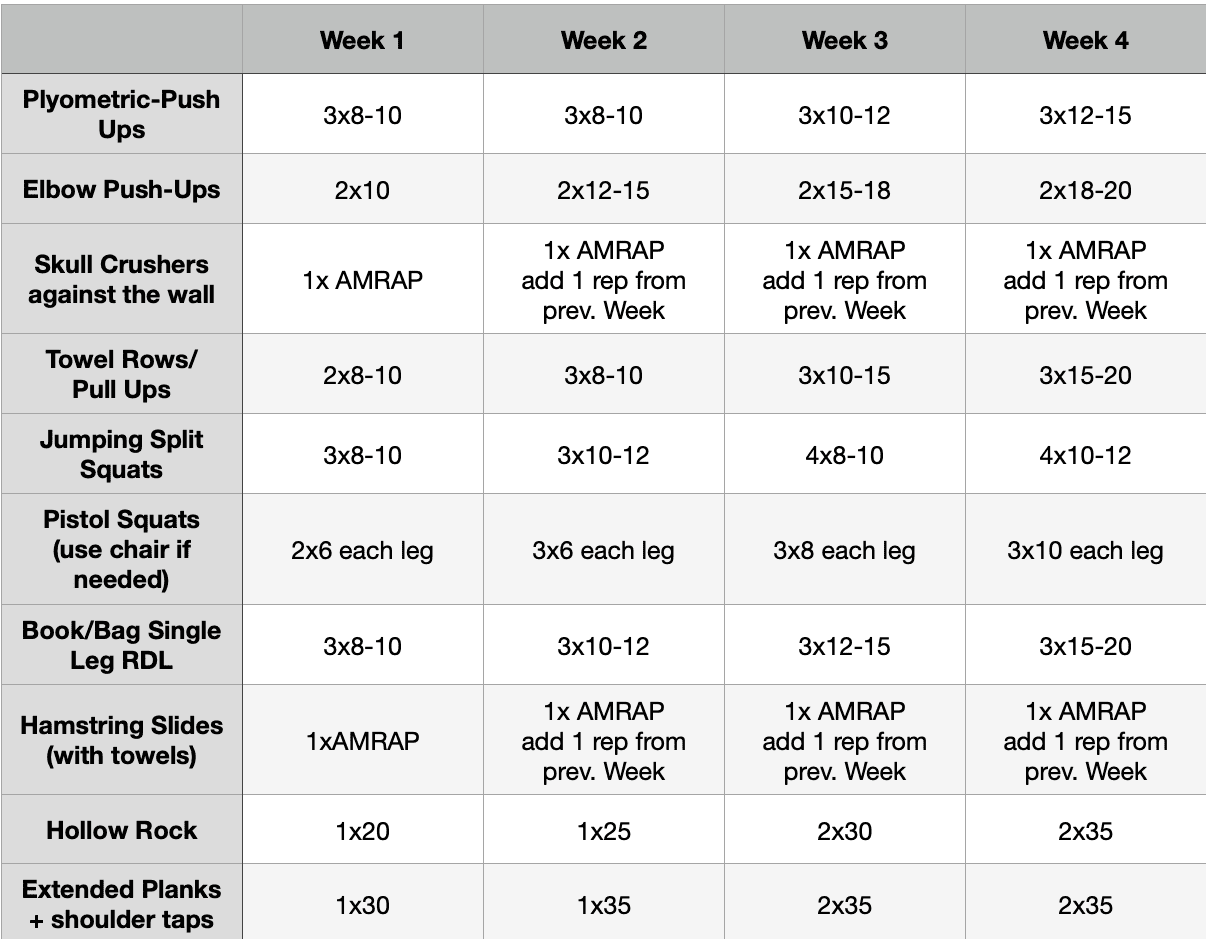
Program Instructions:
For this one, it’s going to be pretty much straight-forward. The plan above is what you’ll have to follow. To make it more challenging, I suggest adding a bag filled with books to increase the resistance. This way, we can alter the intensity, and really play with all the variables that will allow us to maximize the efficacy of the program. In terms of frequency, again, I’d suggest working your way up to a maximum of 4 times per week, as there’s plenty of training volume that you’re going to do per session!
Chest, Arms & Upper-Body Builder
The fourth training program will be a 3/day Upper Body focused workout, which can be performed in a Home Gym Set-up.
By being an upper body “focused” workout, that doesn’t mean we’re cutting lower body off completely. Instead, we’re going to perform enough volume at a high enough intensity to maintain strength and mass for the lower body, while trying to maximize the amounts of energy that we have during the week, to really focus on providing more volume and progress to our upper body. It can be seen as sort of a “upper body – specialization” workout.
Best for, and why:
Since this program can be seen more as a specialization-type split, I would definitely recommend it to more intermediate lifters who notice slow results in their upper bodies. Yes it’s “just” a 3-day split, but don’t understimate it.
Lower body training is NOT be avoided, as it will focus on maintaining current strength levels, but most of the attention is given to upper body muscles. If you’re up for the challenge and you think your upper body is lagging, give this program a try and thank me later!
Table 10—Session A: Upper Power Focus
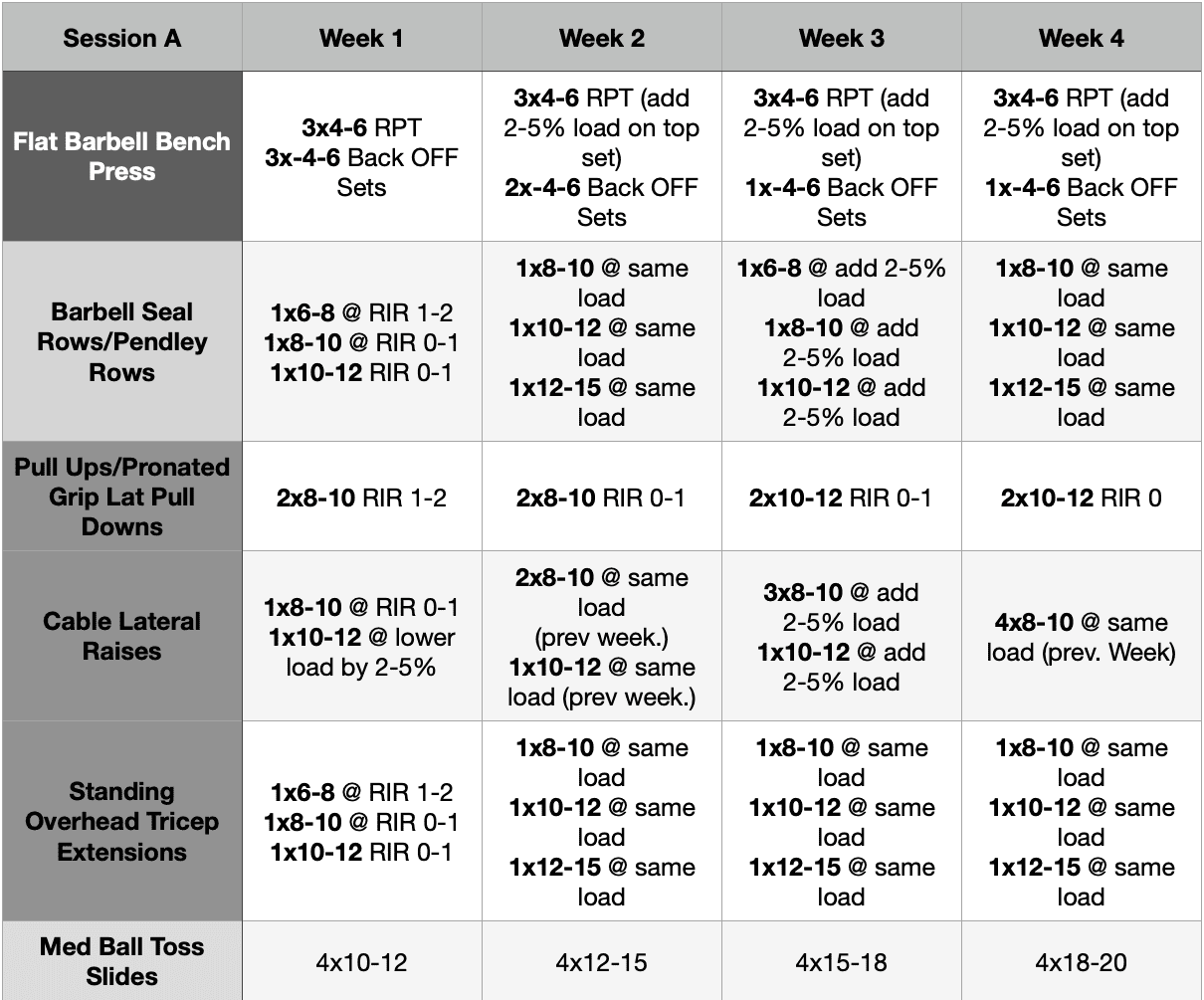
Table 11—Session B: Lower Power (Strength Maintenance)

Table 12—Session C: Upper Hypertrophy (Variations + Accessory)
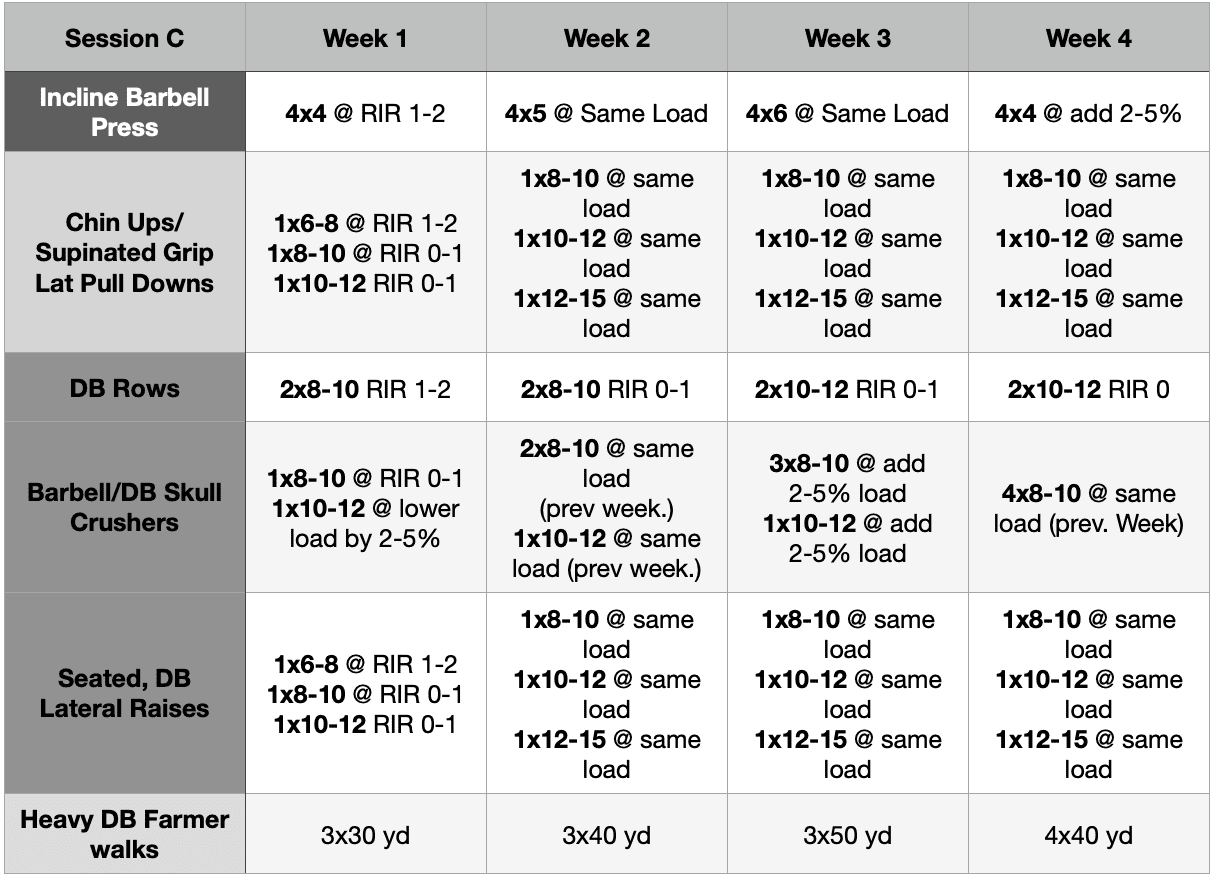
Program Instructions:
Power Exercises: The compound lifts will follow a Reverse Pyramid Style Training, for the first 3 sets of the exercise, with a back off of -10% (based off of the heaviest set), for the following 3 sets in order to accumulate more volume.
Compared to the previous progression seen in program number 1, which has an ascending increase in load. This one will start with the heaviest weight first, then lowering it for the following training sets.
The last 3 sets will be again, based on the heaviest weight lifted in order to keep a high intensity for the prescribed volume.
Keep in mind that sets will get harder and harder as you progress each week. That’s because the goal is to add one more repetition to the set, or a small amount of weight. So do not rush it and really try to maximize the quality of the repetitions you’re performing. If the progression is too fast for you, take your time with it and scale back on intensity, you can always increase the load next week.
Note: if you’re a beginner and you still want to perform this program, stick to only doing the top 3 sets, without doing the back off sets, and progress on a week-to-week basis by doing just that. As you’ll get more accustomed to the program, then start adding 1 up to 3 total back off sets.
Machine/Other accessory Exercises: Other exercises will follow a linear progression, working on Progressive Overload. Increasing the amount of repetitions performed for each set, increasing the load, or adding one more total set to the total training volume for the week. Progression is the name of the game, and if we want to measure progress, we need to do so by constantly exposing ourselves to more stimuli.
Muscle in a Hurry: Myo-reps & Supersets
The fifth and last training program will be a 3/day Full Body workout, which can be performed when “in a hurry”. This means that when we have very little time to dedicate to our training during the week, then a 3 day/full body split can work great.
In order to maximize the efficacy of the program (and make it short enough without sacrificing the training stimulus) I’ve decided to add the Myo Rep training style as well as Super-Sets (in dark grey cells).
Best for, and why:
This program is best suited for intermediate lifters, who are on a rush. The “Short on Time” program focuses on maximizing the amount of effort exerted per session, within a time-restricted scenario in mind.
Although short, I promise it won’t be “a walk in the park”, if that’s what you suspect. To make sure we’re getting the most out of it and grow muscle mass, we still need to create effort-based workouts and progress over time. We’ll do so by using Myo Rep sets and training sets that are very close to task failure!
Table 13—Session A: Upper/Lower Hybrid Strength + Myo Reps
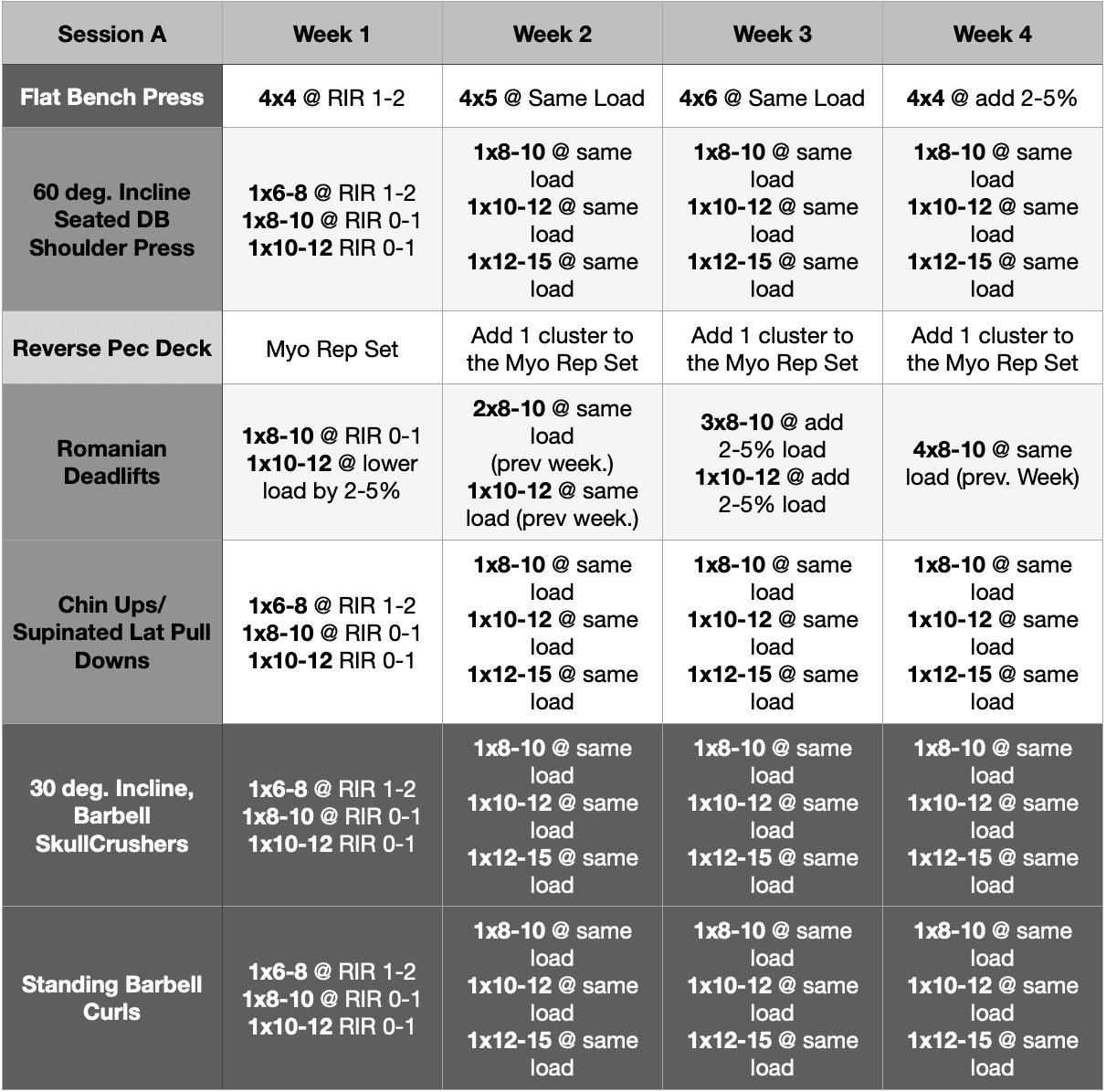
Table 14—Session B: Accessory Strength Reverse Pyramid Training
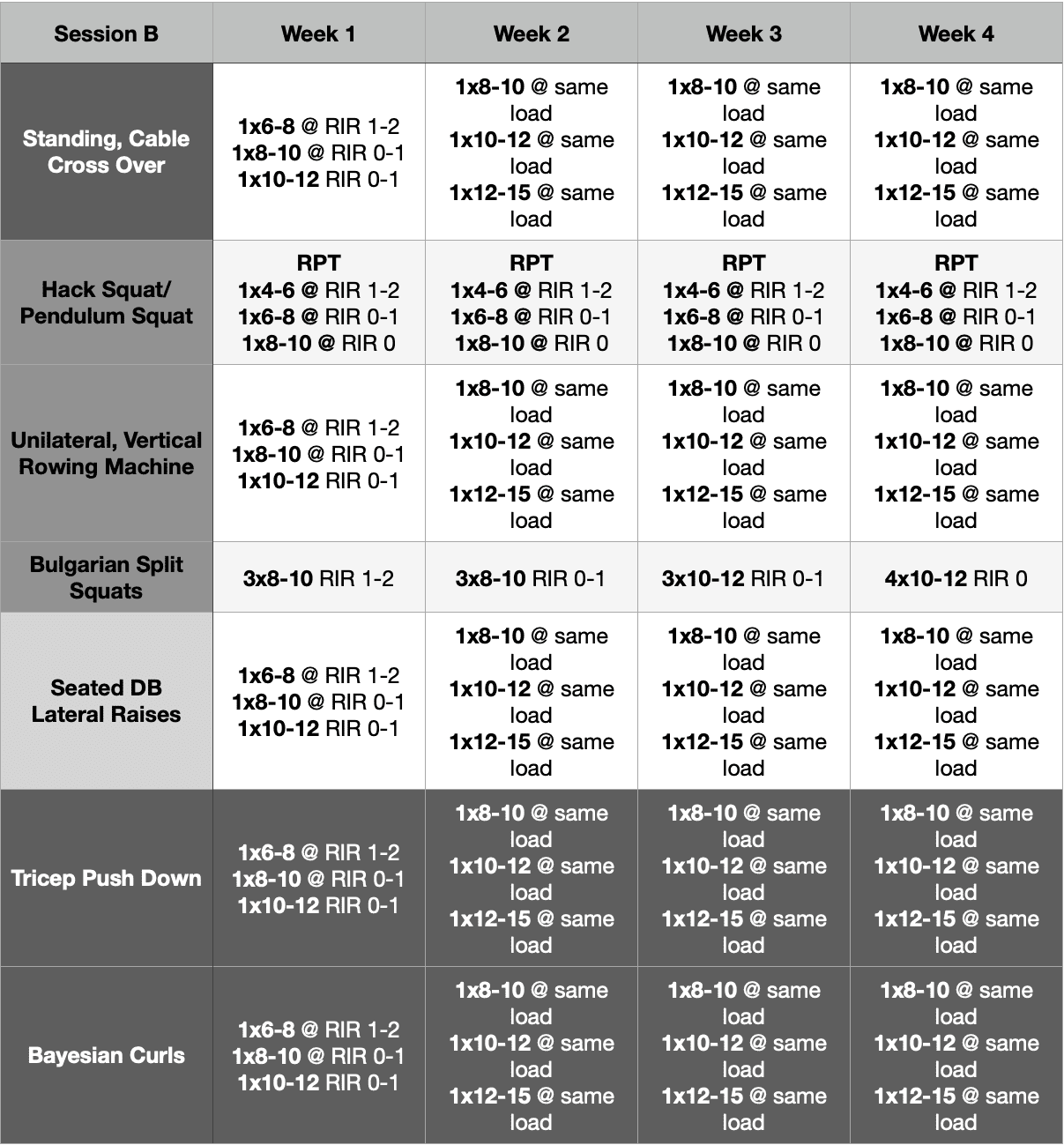
Table 15—Session C: Upper/Lower Mixed Progression
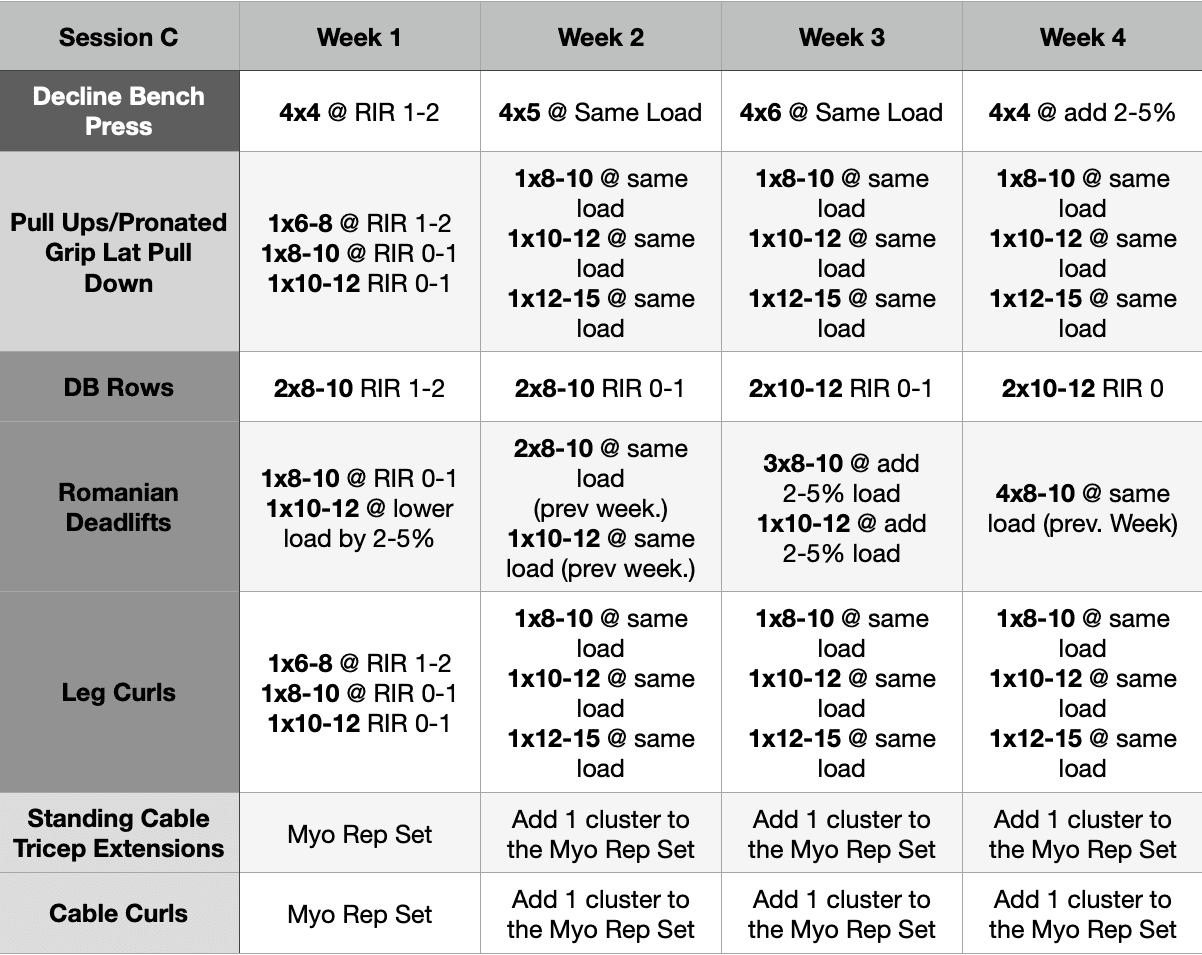
Program Instructions:
Reverse Pyramid Training, Myo Rep sets and Super Sets work will be the meat of this workout plan. For the RPT style training exercises, every first set will have to be the heaviest one. The following ones will serve to accumulate more volume at lower percentages in order to stimulate growth through a good amount of volume. We want to make sure we’re training while using effort-based training methods.
The reason why you won’t see many sets for compound exercises (at least compared to the other presented workouts) is because we’re targeting each muscle frequently, so we can’t fatigue them too much. This way, we can ensure we’re actually able to make progress.
12 quick tips to bulk up faster with your program
Can I use different exercises for the program ?Yes, you can use exercises that you prefer (or that you have access to). I’d recommend sticking to the same movements, by including movements that target the same muscles of the exercise you decide to swap.
How fast can I expect to see results ?This depends on how fast you’re able to make progress, but don’t rush it. Take the time you need and stick to the plan, results come to those who are patient and stick to the plan!
Why isn’t there more isolation work ?Many compound exercises target multiple muscles at the same time, hence the reason why you won’t find many isolation exercises. In a sense, we can say that it’s not “needed” to add additional work. if you feel like you need to add exercises, chances are you’re not training hard enough.
Is Body weight training as effective as Resistance Training ?Body weight workouts can certainly build muscle mass. However, they won’t be as effective as resistance training workouts, in doing so. The reason is resistance, which with weights can be modified precisely in order to progress very fast.
How should I structure the routine during the week ?You can decide that based on your own preference. Generally, I’d suggest going for A-B-REST-C-D-REST-REST for the 4-day training splits.
What about rest time between sets ?I recommend taking the time you need in order to make sure you’re able to complete the next set. That falls betwen 2-5 mins rest, per set, roughly. Of course that changes for Myo Rep Sets and Super-Sets. But that’s because of the nature of the training styles!
Can I use percentages instead of using RIR or RPE ?Sure. Training within a 75%+ or your 1RM for compound lifts will work fine. For other exercises use a weight that allows you to complete the prescribed repetitions with at least 1-2 RIR. Go from there!
What if the program feels too easy ?It’s normal to think that these programs may feel “easy” if you compare them to the standard, high-volume protocols. Keep in mind that we’re working within “optimal” volume ranges recommendations. The workout feels easy ? Add some weight next week. There are plenty of ways to make it harder, and progressing… is one of them!
What if I can do more reps for the set ?Don’t rush it. If you have more in the tank, use that energy next week and increase load. We want to get stronger within a medium rep range!
What if I’m doing the training program but I’m not seeing any progress ?Double check your nutrition and make sure you’re eating enough proteins and calories. If you want to know more about this, I recommend re-reading the previous article. That one goes over “why skinny guys are skinny, and what to do about it”!
Other than that… be patient, make strength progress your TOP priority when training, and don’t compare yourself to others.
Do I need a caloric surplus to build muscle, as a skinny guy ?No, but one will certainly maximize your ability to do so. Refer to the previous answer for further information!
Does my bodyweight have to increase ?Not necessarily, although a caloric surplus will ensure it will happen in the long term. Focus on gaining strength. That’s the most important metric!
A smart workout app to build muscle faster on autopilot
So there you have it.
I just gave you my 5 best workout plans for skinny guys to build muscle faster. These plans go beyond the basics (sets and reps… yawn). Which will you choose?
As we’ve seen, that depends on your level, goals, equipement, and more. In fact, there are many more variables that come into play when it comes to choosing the right program. And fine-tuning it as you build muscle to continue making big gains.
If you can spare the money, your best bet is to hire a personal trainer to guide you along the way. But trainers are expensive. That’s why you can find all my workout plans for skinny guys in a smart workout app called Dr. Muscle (the team behind this blog built it).
For less than the cost of one session with a personal trainer, you can get unlimited coaching with Dr. Muscle for a month. You can work out anytime, anywhere. At home, the gym, or on the road.
After you select your goal, your program is customized to the equipment you have, your fitness level, and more. And when you start working out, your workouts adjust automatically as you do them based on your past and current performance. Dr. Muscle truly puts your progress on autopilot, and automates everything from A to Z for you.
On the fence? You can check out this in-depth review of the 5 best bodybuilding apps (Dr. Muscle was ranked first) or see real user reviews (here are some from the App Store):
Want to build muscle faster on autopilot with programs customized for skinny guys? Try Dr. Muscle for free.
Try Dr. Muscle for free to build muscle faster on autopilot—skinny guy programs included
